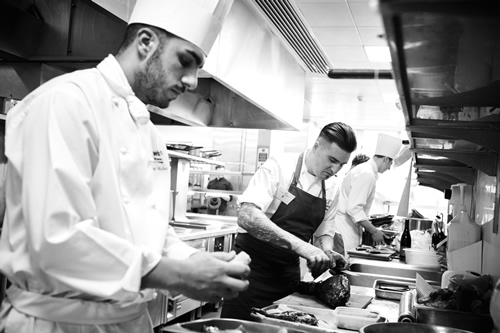'It hasn't really sunk in yet' – Luke Selby on winning the Roux Scholarship 2017
Luke Selby, the latest winner of the coveted Roux Scholarship, cooked a notoriously tricky recipe to win over the judges at the final. Fiona Sims goes behind the scenes at the contest to discover what the judges thought of him.
VIEW PHOTOS FROM THE AWARDS HERE >>
You can hear a pin drop as the six Roux Scholarship finalists take their seats and look up at the daunting line-up of chef judges. Among them are four previous winners: Andrew Fairlie, André Garrett, Sat Bains and Simon Hulstone, plus there's James Martin, Brian Turner and David Nicholls.
Sitting in the middle of this male, Michelin-starred chefdom is the diminutive but powerful presence of Anne-Sophie Pic, France's only female three-Michelin-starred chef. This year, Pic has been chosen as the honorary president of the judges. "The two families are closely linked, so it's a particular honour," she tells me later.
"I know it looks scary, but try and relax," encourages Michel Roux Jr as he introduces everybody. "All of you got to the final on merit and we already know you can cook, so enjoy the day," he adds with a warm smile.
The training restaurant at Westminster Kingsway College is normally packed with tables, but now it's the scene of the hospitality industry's toughest culinary competition, whose winner will gain privileged access to an exclusive chefs' club, not to mention an impressive stash of prizes, including a three-month stage at the three-Michelin-starred restaurant of the winner's choice.
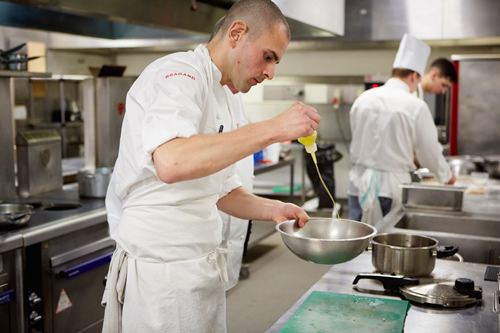
tin Carabott competed last year too. "It's good to get your name out there - though it helps that I've got a lot of support from my boss," says the Luca restaurant chef. The Driftwood hotel's Matthew Whitfield is also no stranger to the contest, competing in the regional heat in 2011 and 2012 - although this is the first time he has got to the final. "I'm in a good position now, so I thought I'd go for it. Though to be honest, I'm just happy to be here," he says.
There is an X-Factor-style pause before Roux Jr reveals the dish the chefs will be cooking: royal-style saddle of hare, chestnut-flavoured tagliatelle and purple sprouting broccoli. "It's a Roux family recipe inspired by Antonin CarÁªme," he tells the finalists, which doesn't help to calm their nerves.
"I reckon most of this lot have never done this dish before," whispers judge Martin. "Or even fumbled around in a hare's cavity before," adds Fairlie, the very first Roux Scholar, who was tasked with briefing the finalists to give them an overview of the day.
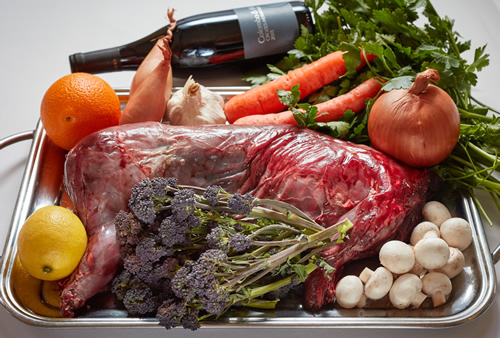
x Jr continues to explain the dish: "There is a bit of room for interpretation. You can use as many ingredients as you want, and you can do what you want with the broccoli," he says. His cousin, Alain, urges competitors to ask questions, but only two finalists raise their hands - there's one query about the ballotine, and another about the serving dish they are to use, before they all settle down to their reference books.
The finalists are allowed half an hour with a set number of cookery books to help them research the dish and draw up their work plans. Everyone has a copy of Larousse and Escoffier, and all have at least one Roux-penned tome, including Michel Roux's Pastry: Savoury & Sweet.
The first finalist is called to the cooking station, and the rest follow at 10-minute intervals.
"I think of all the Roux Scholarship finals I have judged, this dish has to be one of the toughest," says Martin, out of the finalists' earshot. "There are lots of things that can go wrong. There are elements all the way through the dish that you can bugger up."
So just how does this dish rank against those chosen for previous finals? "All the recipes are difficult," explains Roux Jr. "But that's why we impose them: because it gives the chefs an opportunity to showcase their knowledge of classic skills. Every dish we have ever chosen has thrown up a different set of challenges The important thing is that there is room for interpretation. We always deliberately give the chefs far too many ingredients. For this dish, they can use the bread or omit it, they can use the veal liver or not. There are 101 ways they can go with this - it's up to them to surprise us - and that's important. Just as long as it's recognisable as a stuffed saddle of hare," he adds with a grin.
The first half hour is a bloody mess as the finalists eviscerate their hares and drain the blood from the carcass. "I've cooked a similar sauce before, but I've not cooked a hare like this," Martin admits. "I think the hardest element is understanding what the dish should look like - they need to get their heads around that first. I reckon that's the secret to winning this one: have in your head what the dish should look like and then work backwards. The butchery is key, though," he adds as he patrols the workstations.
Pic is transfixed by Dabbous head chef and finalist Luke Selby's saddle, which he is wrapping methodically in the supplied bandages. Yes, medical bandages. "It's the most effective way to keep the farce in and everything tightly rolled," explains Roux Jr. Though with patches of blood seeping through Selby's saddle, it's now looking alarmingly like a severed limb on a surgeon's operating table.
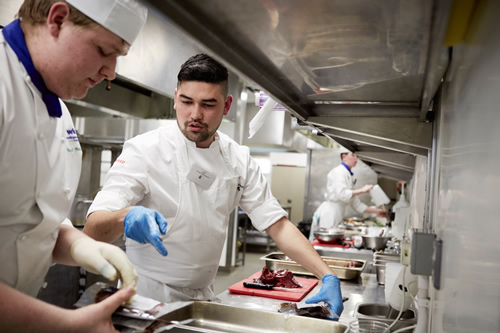

About the hareAnne-Sophie Pic "It is totally fascinating to see how each chef approaches this dish. I think the trickiest bit will be how to cut it. The saddle needs to be whole - you don't want to cut it in the wrong place. You need all your butchery skills for this dish. The second hardest bit is being able to get the best flavours out of it, and the way it all comes together. There are so many variables. The problem with this recipe is that it is very classical and you can fail at every step. With most dishes, if you make a mistake, you can adapt, but with this one you can't take any chances." David Nicholls "What a tough dish. Using combinations like blood and chocolate is always going to be tricky. The sauce has to be just the right temperature, otherwise the blood congeals. And you don't want to use too much chocolate either - you don't want to end up with a chocolate and red wine sauce. And they've got to maximise that saddle - they've got to keep those belly flaps on to keep the farce in there. And chopping the farce by hand isn't easy, either." Sat Bains "Let's be honest, it's a very difficult dish, but that's the beauty of wild game. Each animal will taste different, so each dish will taste slightly different, too. It's a very classical dish. I think the farce is the trickiest bit - you've got to cook it so that it holds its shape, but you've also got to keep it moist. And it needs to be seasoned just right, so they'll have to taste it raw first." Andre Garrett "I love this dish - though the last time I cooked it was probably when I was at the Orrery with Chris Galvin, so a fair few years ago. I think the hardest element is the boning of the saddle and then braising it. You need to keep it all together and keep it moist. I'm also interested to see how they use the calves' liver; whether they chop it up or put strips through it."
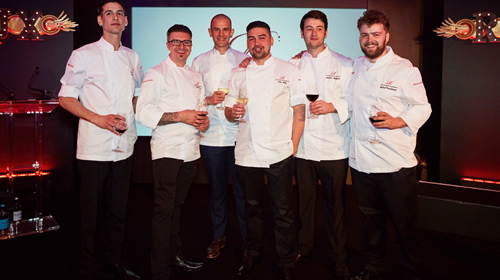
About the winner: Luke SelbyBrian Turner "I think he was quietly impressive. He was in total control from start to finish, but not exuberantly so. What impressed me most was the way he put that ballotine together. It set him apart from the rest. I watched the way he played with it, changed it, and built it. The others were chopping theirs, but Luke was doing thin slices of liver and back fat, which he layered the farce with. That was interesting. "Secondly, I love his personality. He seems like a really nice lad and his personality came through in the food. You felt he wouldn't be prone to outrageousness and that he was in control of himself and the dish. As the hours marched on I felt he was turning into a worthy scholar - remember, we also have to choose people who will fit in with us." Andrew Fairlie "He was so calm in his approach and so meticulous. He was the last finalist to go into the kitchen, which is probably the worst position to be in, yet he showed no panic. Luke took five minutes to set everything up and then he began - all very composed. I particularly liked the way he dealt with the hare. It was all done with surgical precision. He laid out every organ neatly after he had eviscerated it, with a quiet confidence. "Luke is such a lovely, lovely guy, and so humble, too - he'll make the perfect scholar. As well as being an accomplished cook, we've also got ourselves a really good all-rounder. I think he'll be a great ambassador for the scholarship." Sat Bains "Such a worthy winner - I think he'll be a great role model. He's got a great career ahead of him. I loved the fact that his fellow finalist, Ollie Downey, said that he was the best winner and that he couldn't have lost to a nicer guy. That just about summed up the day - the camaraderie was great this year. I loved the way Luke used his instinct when working through the method. He's got some serious skills there - but, he has worked under some great guys, notably Gary Jones and Raymond Blanc at Le Manoir. His seasoning was spot-on - without a doubt, it was the best dish of the day. We were all impressed with his discipline. He was very clean in his approach, and worked well within his own timeframe. He'll fit right in." Simon Hulstone "Luke really knew what he was doing. I loved the way he stepped back and thought about things before continuing. Everything was laid out in front of him first, like a Lego kit. If I was training anyone to do a competition like this, that's how I would have done it. He was a clear winner as soon as the dish came out and the presentation was spot on. The dish was cooked perfectly and it tasted great. He's a model scholar. Yes, everyone struggled with the dish, but Luke more than rose to the challenge."
The judgesJoint chairman Alain Roux, chef-patron, the Waterside Inn, Bray, Berkshire Joint chairman Michel Roux Jr, chef-patron, Le Gavroche, London Honorary president of the judges 2017 Anne-Sophie Pic, chef-patron, Maison Pic, Valence, France, and La Dame de Pic, Four Seasons Trinity Square London Vice-chairman Brian Turner, president of the Royal Academy of Culinary Arts Head scholar Andrew Fairlie, chef-proprietor, Restaurant Andrew Fairlie, Gleneagles Judges •Sat Bains, chef-patron, Restaurant Sat Bains, Nottingham •Andrew Garrett, executive head chef, Cliveden House, Taplow, Berkshire •Simon Hulstone, chef-proprietor, the Elephant, Torquay, Devon •James Martin, chef-proprietor, James Martin Manchester 235 Restaurant, and consultant chef, Chewton Glen •David Nicholls, group director F&B, Mandarin Oriental Hotel Group The finalists Martin Carabott, Luca Restaurant, London Michael Cruickshank, Bohemia, St Helier, Jersey Scott Dineen, BaxterStorey (Black Rock), London Oliver Downey, Fera at Claridges's, London Luke Selby, Dabbous, London Matthew Whitfield, the Driftwood Hotel, Portscatho, Cornwall
The recipeRoyal-style saddle of hare, chestnut flavoured tagliatelle and purple sprouting broccoli, from the Roux family, inspired by Antonin CarÁªme To begin, cooks must prepare the hare by butchering it. The innards should be removed, but the liver, heart, kidneys and lungs should be retained for the stuffing and/or sauce. The blood from the stomach should be kept to bind the sauce. The middle part of the hare, the saddle, must be used to obtain a single piece of completely boned hare that can be formed into a ballotine shape. Other parts of the hare should be reserved for the farce, cooking liquor and sauce. With a knife, cooks should cut a force meat using hare meat and other ingredients to make a tasty, moist farce. The saddle should be seasoned well and the farce spread over the surface, along with other ingredients chosen to stuff the saddle. The sides of the hare should be used to wrap and hold the stuffing in place, and it should be tied into a large sausage shape. The saddle is then braised gently. Some of the reduced braising liquid should be used for the sauce. A little bitter chocolate gives smoothness and shine to the sauce. When cooked, the saddle should be cut into four or eight slices, placed on a suitable dish, and garnished with chestnut-flavoured tagliatelli, plus purple sprouting broccoli. The dish should be accompanied with warm hare sauce.
Roux Scholarship 2017 winner Luke Selby "It hasn't really sunk in yet," grins Luke Selby, speaking the day after he scooped first prize at the 2017 Roux Scholarship. He celebrated like any young chef would - down the pub near the competition venue, London's starry Langham hotel. So just why did he put himself through what is arguably the toughest chef competition out there? "It seemed like the right time in my career to enter," says the 26 year old, who, it turns out, is rather good at winning chef competitions. In 2012, he won the kitchen category at the Annual Awards of Excellence, then in 2013 he won the Craft Guild of Chefs' Graduate Award, and in 2014 he won the Young National Chef of the Year title. "I can't get enough of competitions," he laughs. "I think it's important to keep challenging yourself. You learn so much in the process." Born to a Filipino mother and English father, Selby was brought up predominantly in rural Sussex. The eldest of four brothers, he often took on the responsibility of cooking for the family when his parents worked late. "I loved cooking programmes - couldn't get enough of them," he says. "I watched everything from Ready, Steady, Cook to Jamie Oliver." As a teenager he started working part-time at the weekends in a local restaurant called Wyatt's, and he cites its head chefs Ben Goldsmith and Michelin-starred-restaurant-trained Stuart Dove as early inspirations. At 16 years old, he entered his first chef competition, Rotary Young Chef, and came second, catching the attention of guest judge Raymond Blanc. "I wrote to him the day after, asking if I could come and do some work experience with him. He remembered me and said yes." Selb went on to finish his A-levels before securing a full-time position as commis chef at Belmond Le Manoir aux Quat'Saisons. "I was always going to work in a kitchen - I knew I was good at it. At first, dad was pushing me to go to university, but when I insisted that I wanted to cook for a living, he told me to go for the top, so I applied for a job at Le Manoir." Selby worked under Blanc and executive chef Gary Jones for the next six years, working his way around the sections until he was promoted to sous chef. "It gave me such a great foundation," says Selby. He then went on to spend time working under Clare Smyth at Restaurant Gordon Ramsay. "It was tough. Every day was relentless, but I enjoyed every second. It was amazing to work with those people," he says. From there, Selby moved on to Dabbous, working under its creative, eponymous chef owner. "Ollie is one of the few chefs in London who actually owns their restaurant and that interested me. Plus he is ex-Le Manoir and he has a Michelin star - so I'm hoping to follow a similar career path," he says. So where would Selby like to spend his three-month stage? "I've not thought about it properly yet - maybe Japan? As I'm half-Asian I want to tap into that Asian influence. The food and the people in Japan fascinate me, so does their respect for produce and their work ethic." And yes, Selby wants to own his own restaurant one day. "Every chef wants that, don't they?" he says. But for now he is focusing on his position at Dabbous, where he has just been promoted to head chef - two weeks before being made a Roux Scholar.
The prizes Luke Selby receives £6,000 to support his career development, and an invitation to cook and train under the supervision of a leading chef at a three-Michelin-starred restaurant, anywhere in the world, for up to three months. In addition, he also receives: •A gift box of dry-aged steaks, courtesy of Aubrey Allen. •Two personalised, Roux Scholarship chef's jackets, courtesy of Bragard UK. •An invitation for two to Rick Stein's in Padstow, including two nights' accommodation at either the Seafood Restaurant or St Petroc's hotel, a three-course dinner with a bottle of wine at the Seafood Restaurant and two places on a one-day cookery course at Padstow Seafood School, courtesy of Bridor. •A year's subscription to print and digital editions of The Caterer for one year, plus two tickets to the Cateys. •A classic collection of Global Knives and a range of accessories: peeler, fishbone tweezers, tongs, scissors and whetstone sharpener, all contained in a chef's case. •Four VIP tickets to the Goodwood Revival Festival, plus three cases of Still Hildon Natural Mineral Water, delivered to his home each month for a year, from Hildon Natural Mineral Water. •Complimentary membership of the Institute of Hospitality for one year. •An exclusive Magnum of Laurent-Perrier Cuvée Rosé Brut, signed by all the judges. •An all-expenses-paid trip for two to visit the wine cellars of Laurent-Perrier at Tours-sur-Marne, travel by Eurostar and overnight accommodation with dinner, bed and breakfast. •A coffee machine for the home, plus a trip for two to visit the award-winning Caffé Musetti roasting factory, with flights, transfers and a night's accommodation in Milan, courtesy of L'Unico. •A tour of Rungis market in Paris with Mash Purveyors' team of buyers, including travel and overnight accommodation, plus an invitation to Mash Purveyors' Mashup Festival of Food in September. •A day's work experience with Steve Groves, MasterChef: The Professionals' winner, at Roux at Parliament Square, followed by dinner for two in the restaurant, courtesy of Restaurant Associates. •A day at TRUEfoods followed by a gastronomic food tour of Barcelona, includes flights, meals and three nights' accommodation. •A day of game shooting with one night's accommodation, including dinner, bed and breakfast, courtesy of Udale Speciality Foods. VIEW PHOTOS FROM THE AWARDS HERE >>](/media/32/the-roux-scholarship-2017-luke-selby-from-one-michelin-starred-restaurant-dabbous-has-been-named-winner-of-the-2017-roux-scholarship/photos) Photos by Jodi Hinds ([www.jodihinds.com/) Save Save


